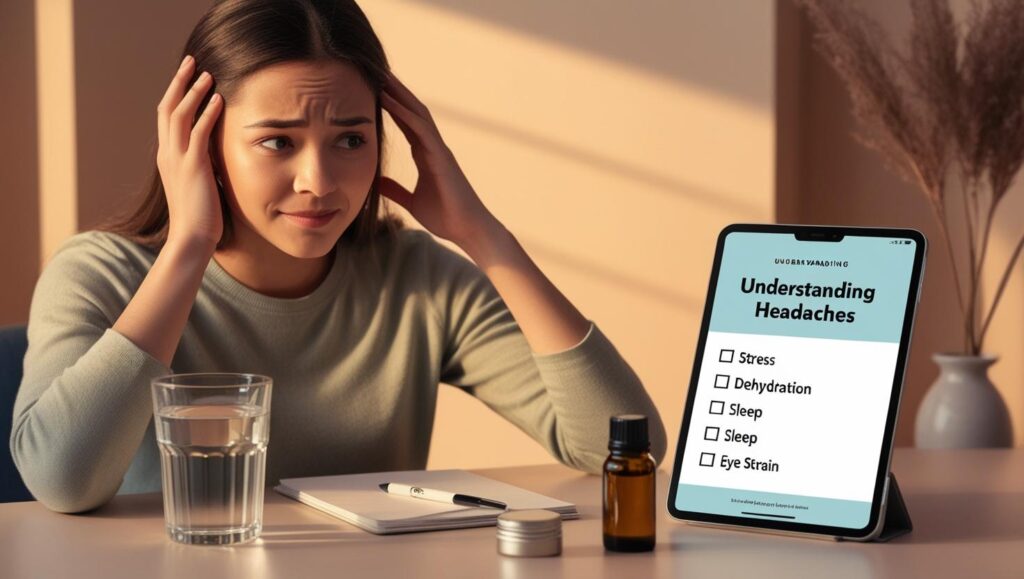Headaches are one of the most prevalent health complaints in the world, occurring daily in millions of people. From the occasional tension headache to the chronic migraine, they are a nuisance in daily life. But then there are others who are getting them daily. Is it normal, or is there a reason to worry?
Short answer: no, a daily headache is not normal. While headaches are not unusual from time to time, daily headache activity may mean there is a problem that requires medical intervention. Today, we’re going to look at why you have chronic headaches, the types of chronic headaches, if and when to consult a physician, and how you may alleviate them.
Understanding Headaches
Before we can understand the meaning of having daily headaches, it’s necessary to know the various types of headache and the usual factors causing them.
1. Primary and Secondary Headaches

Primary headaches are not caused by another underlying medical condition.
Tension-type headache
Cluster headaches
Secondary headaches are a sign of another problem, including:
Sinus infection
Head injuries
High blood pressure
Brain tumors (occasionally)
Medication overuse
Both types of headache can occur on a daily basis, depending on the reason.
What are daily persistent headache
Headaches that occur daily can be classified as Chronic Daily Headaches (CDH) if they are experienced 15 or more days per month over a span of at least three months. CDH is not a diagnosis but a classification that covers a number of different types of headaches that are frequent.
There are four principal forms of chronic daily headaches.
Chronic migraine
Chronic tension-type headache
New daily persistent headache (NDPH)
Hemicrania continua
Let’s go through each briefly.
1. Chronic Migraine
These are migraines that occur over 15 days a month, frequently accompanied by sensitivity to light and sound, and by nausea and a throbbing headache. They can develop from episodic migraines over time.
2. Chronic Tension-Type Headache
Less severe than migraines, they are typically a dull, pressing ache on each side of the head. Unlike migraines, they are not usually accompanied by nausea or sensitivity to sound and light.
3. New Daily Persistent Headache (NDPH)
NDPH comes on abruptly and is daily and persistent from onset. The headache persists for months to years and in many cases is not easily treated.
4. Hemicrania Continua
A chronic kind of headache that is persistent on one side of the head. It is most effectively treated with a drug known as indomethacin.
Typical Reasons For Everyday Headaches
If you are suffering from frequent daily headaches, there could be one or multiple underlying causes to the frequency. Among the most prevalent are
1. Stress and Anxiety
One of the primary causatives of tension-type headache is chronic stress. Anxiety creates tension in the muscles, clenching of the jaw, and poor sleep, all of which may lead to daily headache.
2. Meds Overuse
Ironically, frequent consumption of headache pills can lead to “rebound” or overuse headache. It occurs if painkillers are used 2-3 days a week.
3. Poor sleeping habits
Inadequate sleep, poor-quality sleep, or sleep conditions such as sleep apnea may lead to or exacerbate headache. Your body and brain require adequate rest to perform efficiently.
4. Dehydration and Nutrition
Hunger, dehydration, or not drinking enough fluid can lead to headache. Caffeine or too much alcohol consumption can also do the trick.
5. Hormonal Changes
Hormonal changes, particularly those that occur in women during menstruation, pregnancy, or menopause, can cause daily headaches.
6. Vision Issues
Uncorrected vision issues or a lot of screen time can strain your eyes and lead to forehead or temple area headaches.
7. Underlying Medical Conditions

Some of these conditions include high blood pressure, infection, or more serious conditions like a brain tumor or aneurysm (although these are not common).
when do you need to worry
Most headaches are not life-threatening, but daily headaches must not be dismissed—especially if
They started suddenly and have become daily
They are getting increasingly worse
They awake you from sleep
Alongside neurological signs (blurred vision, confusion, speech disturbances, weakness)
You have a history of cancer or immunologic conditions
You are over 50 and noticing new headache patterns
If you fall under any of the above categories, consult a doctor immediately.
Obtaining a Proper Diagnosis
Uncovering the cause of daily headaches requires a thorough medical exam. Your physician will probably
Take a detailed headache history (onset, location, severity, duration, triggers)
Review your medications, lifestyle, and medical history
Ordering imaging tests (such as MRI or CT scan) if they are suspecting a more serious cause
Consider keeping a headache diary to monitor patterns and triggers.
You could possibly be referred to a headache specialist or a neurologist to evaluate you further.
Treatment Options

Treatments that are appropriate depend on the type and cause of headache. These are a sampling of the most used techniques:
1. Drugs
Preventive drugs: For chronic migraines or tension-type headache, a physician can prescribe antidepressants, beta-blockers, anti-seizure drugs, or CGRP inhibitors.
Abortives: These are used at the start of a headache (e.g., migraine triptans).
Indomethacin: A highly effective NSAID in the treatment of hemicrania continua.
Botox injections: FDA-approved for chronic migraines.
2. Lifestyle Changes
Establish a routine of regular sleeping.
Stay hydrated and maintain regular, nutritious meals.
Restrict screen time and maintain proper ergonomics in the workplace.
Include stress-reducing practices (meditation, yoga,
3. Treatment
Cognitive Behavioral Therapy (CBT): Can assist in reducing tension and anxiety that are causing headaches.
Physical therapy: Especially beneficial to those suffering from tension-related headache caused by muscle strain or poor posture.
Biofeedback and relaxation skills: Helpful in learning to manage body responses to tension.
4. Alternative and Complementary Treatments
Massage therapy
Chiropractic care Magnesium or riboflavin supplements under medical supervision
How to Prevent Daily Headaches
Here are a few tips to assist you in minimizing or eliminating daily headaches.
Keep a headache diary: Write down when you have a headache, what you ate, how you slept, how stressed you feel, and anything else.
Trigger Identification and Avoidance: These may be food, changing environments, or stress factors.
Exercise regularly, proper diet, enough sleep, and hydration are the keys to a healthy way of life.
Limit caffeine and alcoholic beverages: Both may cause or exacerbate headache.
Establish limits around screens: Use blue light filters, take frequent breaks, and set screen heights to minimize strain.
Concluding Remarks
Headaches that occur on a daily basis are not normal and must be treated seriously. Though generally not life-threatening, they can significantly affect the quality of life and can also represent a sign of a problem that requires treatment. The positive news? Most frequent daily headache cases are treatable and even preventable using proper treatment and a modification of one’s way of life. Do not diagnose yourself or just ignore the issue. Frequent headache sufferers, speak to your physician and initiate a process of relief. Your life—and your brain—are worth it.
![]()






